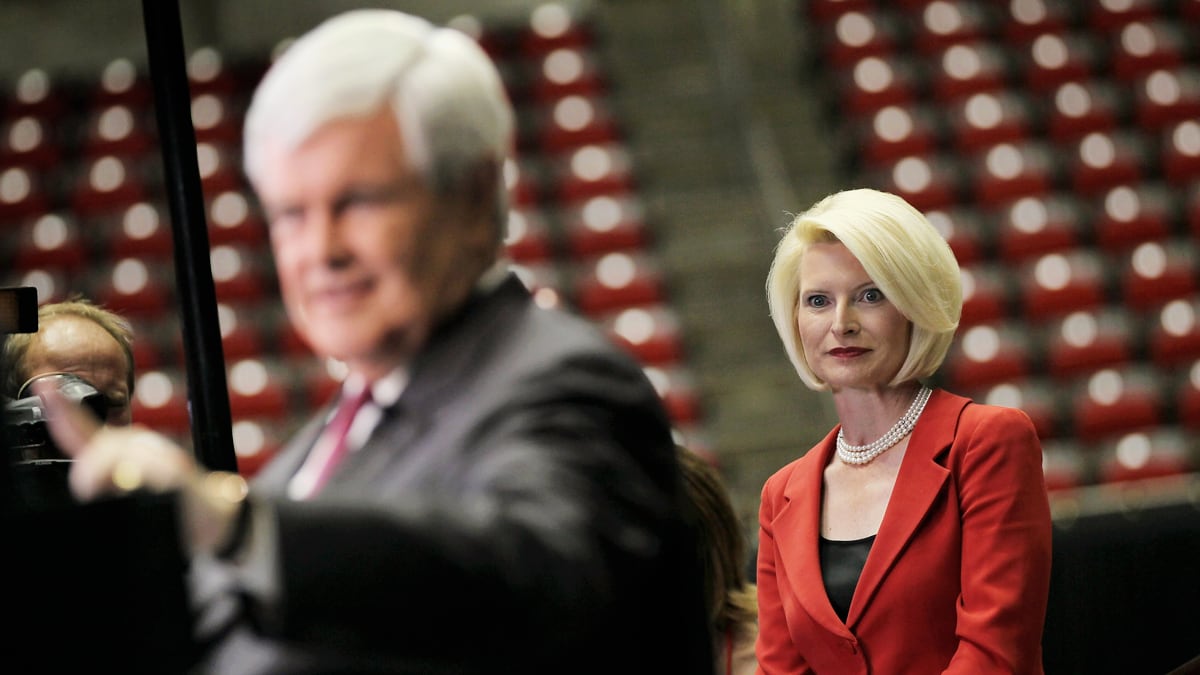
A constant presence by her husband’s side as he campaigns for the Republican presidential nomination, Callista Gingrich is distinguished by her style—by every aspect of her appearance over which she can exert control. From her square-shouldered suit jackets and triple strand of pearls to her paint-by-the-numbers makeup and rigidly perfect hair, it is hard not to linger over her appearance and consider the effort required to maintain it.
Last week, she sat in the audience at Washington’s Ronald Reagan Building & International Trade Center listening to her husband, Newt, quote Abraham Lincoln and Albert Camus in his discussion of juvenile employment and U.S.-Israel foreign policy. She was dressed in a variation of her usual uniform. The shoulders of her restrained black jacket were molded into perfect right angles. Her pearls glistened. Her platinum bob, with its swoosh of side-brushed bangs, was eerily flawless.
Saturday night, at the Republican primary debate in Iowa, she was again dressed in black. The dark palette of her clothing made the shimmering perfection of her hair all the more evident.
Mrs. Gingrich’s grooming is distractingly impeccable. In an era of relaxed dress codes and wash-and-go hair, her style is painstakingly starched from head to toe. If she were to slouch, she just might crack.
This wasn’t always so. Images from her earlier days on Capitol Hill show layered hair that moved at the whims of the wind. It wasn’t so platinum, it wasn’t so high maintenance, and it wasn’t so head-turning. Mrs. Gingrich’s style has evolved from that of a young professional who looked as if her closet might have been an outpost of Ann Taylor to a woman who has set out to exude wealth, control, and exceptionalism.
Her style runs contrary to that typical of the women and men whose professional lives are chronicled by C-Span and Washington’s press corps. These power brokers customarily steer clear of displaying any interest in style beyond the basic requirement of looking appropriately and professionally turned out. Revealing that one has a relationship with hair-care products and a jeweler’s loupe would suggest that precious seconds in a day that should be wholly devoted to big thoughts, serious ideas, and various kinds of wonkery were wasted over vanity.
The unspoken rule of political style: do not tempt audiences into pondering how much mirror time one requires—or indulges in—on a daily basis. Already, media estimates have put Mrs. Gingrich’s hair-care time at anywhere from 45 to 90 minutes a day.
In contemporary fashion, as well as in politics, style is supposed to look effortless. When effort is apparent, it is damning. It doesn’t matter if a woman takes hours for full hair and makeup, as long as the result looks as if it took only 15 minutes. Imperfection is a mark of modern sophistication, confidence, and youthfulness. Formal gowns are paired with tousled curls or leather jackets; tuxedos are worn with a 5 o’clock shadow; precious gems are accessories to jeans; bespoke suits are matched with cowboy boots.
The goal is to display wealth and status as if by accident rather than intent, to suggest that formality is a barrier to be breached.
To do otherwise, to display one’s good fortune in the form of hyper-grooming, is to exist in the real-life superficial world of Real Housewives, where lunch with a girlfriend requires a blowout, eyelash extensions, and a new pair of shoes. It is to live in a Trumpian universe where money is bragged about with pugnacious glee, fancy toys become cudgels, and expensively maintained women attach themselves to wealthy, walrus-like men. In that world, a carefully gilded creature such as Callista Gingrich would not draw a second look.
In the broader, contemporary culture, however, her closely tailored blazers, precisely applied makeup, glossy nails, and hair that never requires a glancing adjustment all exude an excruciating prissiness. Her many style tics—stacked one atop the other—read as code for narcissism, self-indulgence, and brittle self-absorption. Hollywood has taught us this code. So have Madison Avenue and Seventh Avenue.
History shows that Mrs. Gingrich’s style once might have been interpreted more kindly, or gone wholly unnoticed. One need only look to the women of Mad Men for a nostalgic glimpse of a time when grooming was a multistep process that required time and precision—and evidence of exertion, from the carefully drawn cat eyes to the dutifully teased bouffant, was applauded. Formality was de rigueur; it was a sign of good manners. Back then, women not only dressed up, they dressed older. Daughters mimed their mother’s style, not the other way around, as happens today.
Callista Gingrich stands out because, like a woman of the 1950s and early 1960s, she is dressing beyond her years. Youthfulness is not her obsession. Control and order are.
In some ways, her style is reminiscent of Cindy McCain’s when her husband, Sen. John McCain, was campaigning for president. Cindy McCain exhibited a similar richness, attention to detail, and formality. Mrs. McCain, 57, is a dozen years older than Mrs. Gingrich, 45. Yet they could almost pass for contemporaries. In hindsight and by comparison, Mrs. McCain often looked younger than her years thanks to her generally more relaxed hairstyle and girlish flourishes. While she looked like the benevolent heiress in her Oscar de la Renta shirt dresses, Callista Gingrich’s perfectly tailored suits suggests she might spritz errant voters with Purell should they get too close.
The road to the White House is neither orderly nor regimented. It’s bumpy and filled with unexpected turns. It’s lined with greasy diners, bowling alleys, unruly town-hall meetings, and a lot of calloused hands waiting to be shaken. Style can be used to break down barriers. It can show stature and authority and also exude commonality.
But when it is too perfect, too formal, too stiff, it sets one apart. In Mrs. Gingrich’s case, style implies a social hierarchy that, far from exuding empathy, reflects the haughty airs of noblesse oblige.






